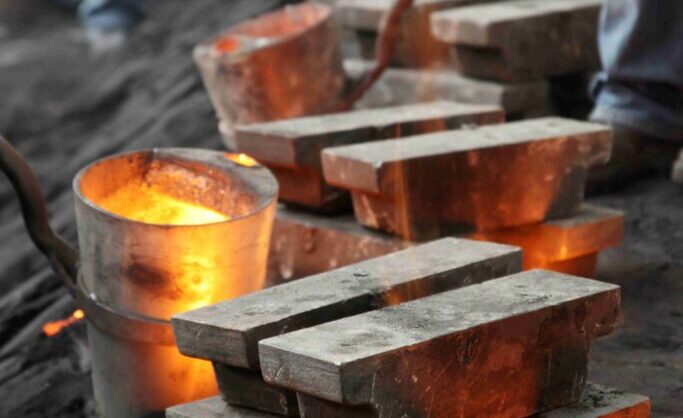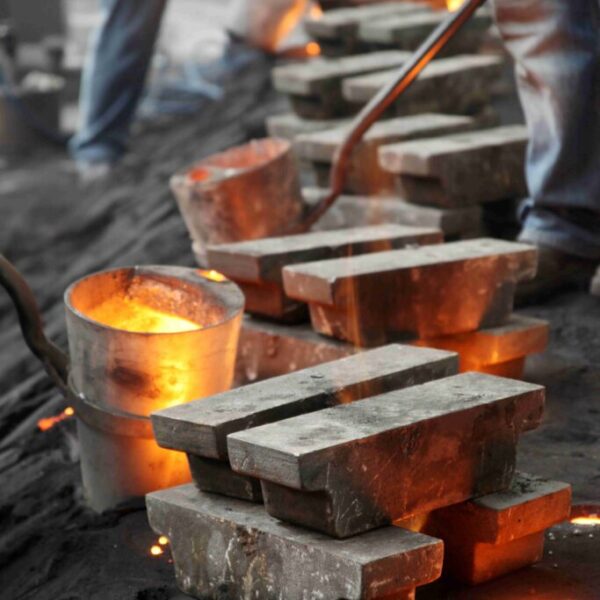Institute of Metallurgical and Foundry Engineering
Research
Research Competences
Computer Modeling of Foundry Processes
Computer Modeling of Foundry Processes Using Various Simulation Software.
Applied software:
Novaflow&Solid (CV = Control Volume method)
SIMTEC/WINCAST (FEM = Finite Element Method)
Flow3D (based on the CFD = Computational Fluid Dynamics method)
With the help of these software tools, it is possible to simulate the mold filling and solidification processes of both pressure die casting and gravity casting technologies. The simulations allow the investigation of air entrapments occurring during mold filling, as well as the hot spots and porosities observable during solidification. Furthermore, by using the SIMTEC/WINCAST software, the simulation of residual casting stresses can also be performed.


- Laboratory Equipment:
- The laboratory is equipped for mold filling and solidification simulations using the following software:
- SIMTEC/WinCast finite element simulation software
- NovaFlow&Solid control volume simulation software
- Flow3D CFD simulation software
- The laboratory features high-performance computer workstations and dedicated servers that ensure the fast and reliable execution of complex foundry simulations.
- In addition, advanced data processing and visualization systems are available, enabling detailed evaluation of the processes and graphical presentation of the results.
- The laboratory’s facilities also provide opportunities for supporting joint research and development projects with industrial partners, as well as for conducting practical demonstrations for educational purposes.
Foundry Sand Testing
Qualification of the Properties of Molding and Core Sand Mixtures, as well as the Properties of Binders Used in Core Making
Examination of the Granulometric Characteristics of Foundry Sands
In the examination of granulometric characteristics, the grain size distribution, specific surface area, and grain shape of the sand are analyzed.
The grain size distribution of foundry molding sands is tested using a sieve shaker equipped with a Hungarian standard sieve set; if required, a German standard sieve set can also be applied.
The testing setup includes an analytical balance with an accuracy of 0.01 g.
The specific surface area of the sand is measured with a DISA-manufactured device designed for this purpose.
The shape of the sand grains is inspected using a stereomicroscope.
Determination of the Specific Surface Area of Granular Materials
The specific surface area is one of the granulometric characteristics of sand. It is a particularly important parameter that must be continuously monitored both when purchasing foundry sand and during its use. It influences several properties of the molding mixture, such as strength, gas permeability, and binder absorption.
Determination of the Moisture Content of Granular Materials
The moisture content of foundry sands and powders is determined using a digital moisture analyzer (Kern DBS 60-3 moisture analyzer).
Determination of the Sludge Content of Foundry Sand Mixtures
This test determines the amount of the dust fraction with a particle size smaller than 0.02 mm in sand mixtures. The mixing process is carried out with a Multiserw Morek – Lsz-2 Sludge Mixer.
Examination of the Properties of Wet Bentonite Molding Mixtures
Standard test specimens prepared from the molding mixture are examined for compactability, gas permeability, compressive strength, wet tensile strength, and active bentonite content.
Examination of the Hot Deformation Properties of Sand Cores
In this test, the deformation behavior of sand cores under thermal load is studied. The standard test specimens are produced and tested on a hot-distortion testing device.
Examination of the Strength Properties of Standard Test Specimens Made from Molding and Core Sand Mixtures
This includes the determination of the compressive, shear, bending, and tensile strength of standard test specimens prepared from various core sand mixtures.
The preparation of the specimens is carried out using a special laboratory core shooter, which—depending on the applied tooling—enables the production of standard test specimens (e.g., bending test specimens, hot-distortion specimens) from different core sand mixtures using Hot-Box, Cold-Box, Croning, and inorganic water glass core-making technologies (e.g., the Inotec process).
Through these examinations, it becomes possible to study the influence of the amount and quality of sand, binder, and additives on the strength properties of the cores.
- Equipment of the Sand Testing Laboratory:
- Fritsch Analysette 3 Pro vibratory sieve shaker
- DISA specific surface area measuring device (POF)
- Kern moisture analyzer balance
- Multiserw Morek Lsz-2 sludge mixer
- Multiserw Morek TYP LM 2c roller mixer with kollergang
- +GF+ ramming device
- Multiserw Morek compaction device
- DISA electric gas permeability tester
- DISA compressive strength tester
- Additional Equipment of the Sand Testing Laboratory:
- DISA wet tensile strength testing device
- DISA hot tensile strength testing device
- PMK measuring device for determining active bentonite content
- Multiserw Morek laboratory sand mixer TYP LMB-U
- Simpson Gerosa laboratory core shooter
- Simpson Gerosa Hot-Distortion testing device
- Multiserw Morek core shooter LUT
- Multiserw Morek universal strength testing device LRu-2e
Examination of Foundry Aluminum Alloy Melts
Melting and Melt Qualification
Comprehensive review of melting technology and consulting. Examination of scrap causes traceable to melt and metal quality, as well as testing and development of alloys.
Examination of the Cooling Behavior of Foundry Aluminum Alloy Melts
During thermal analysis, the transformation processes occurring during the cooling of the melt are monitored as a function of time and temperature.
Examination of the Inclusion Content of Foundry Aluminum Alloy Melts
The purpose of this test is to determine the purity level of alloy melts, performed on a K-sample poured into a specially designed mold (preheated to 200 °C).
Determination of the Density of Foundry Aluminum Alloy Melts
This test method determines the dissolved gas content of alloy melts, thereby enabling the evaluation of the effectiveness of melt degassing operations.
Measurement of the Temperature of Foundry Alloy Melts
Temperature values of melts are recorded using data acquisition systems designed for temperature measurement.
Application of Special Data Acquisition Systems for Specific Examinations
The Institute is equipped with a QuantumX data acquisition device (QuantumX 840B), an 8-channel universal measurement system with a maximum sampling rate of 40 kS/s per channel. The device is suitable for measuring temperature, pressure, displacement, strain, force, etc., and can be used both for educational and research purposes.
In addition to the QuantumX, the Institute also possesses two NI data acquisition devices for temperature measurement (NI USB-9211 A4-CH, 24 BIT; NI USB-6009 14 BIT). These are applied in both teaching and research for temperature measurement of melts and the study of cooling behavior.
Production of Melts Using Melting and Holding Furnaces
The furnaces are used for the production of copper, bronze, aluminum, cast iron, and steel melts. Examination of scrap causes traceable to melt and metal quality, as well as testing and development of alloys, is also carried out.
- Laboratory Equipment:
- QuantumX 840B data acquisition device
- K-mold (for K-sample testing)
- Stand for thermal analysis
- MK 3VT device for determining the density index
- MK 2200 precision balance (accessory of the MK 3VT device)
- Silvercut CN-205M2 precision cutting machine
- 3 induction melting furnaces for melting 20–100 kg of steel, cast iron, and copper alloys
- 1 TCAL 50 furnace for aluminum melt production: for melting 4–100 kg of aluminum alloys
- 1 aluminum melting furnace
- 1 resistance-heated copper melting furnace

Die Casting
In the Institute’s workshop hall, a cold-chamber die casting machine (Die Casting Machine IDRA OL-160 and its accessories) is in operation, currently equipped with two different molds. It is suitable for both educational and research purposes.
In the past year, the Institute has conducted several die casting courses for external companies, where participants not only learned the theoretical foundations but also gained practical experience directly on the machine.
Both molds are single-cavity. They enable the production of an outflow test specimen (R-plate specimen) and a set of tensile bars (6 specimens with different wall thicknesses).
In addition to addressing die casting–specific questions, consulting services are also available.
Material Testing and Failure Analysis of Castings
Microscopic Examination with Zeiss Stemi Stereomicroscope and Zeiss Axio Light Microscope
Examination of Castings and Identification of Defect Causes
Microscopic examination of fracture surfaces and macrosections of various samples in three dimensions is carried out using a Zeiss Stemi 2000C microscope equipped with a Schott KL 1500 LCD transformer.
Microscopic examination of different types of polished samples (aluminum alloys, cast irons, copper alloys) is performed with a Zeiss Axio Observer microscope, equipped with a digital camera (AxioCam ICC3).
3D Printing – Sample Preparation
Printing of Designed Parts and Products from Plastic and Metal
Equipment of the Additive Manufacturing Laboratory:
Formlabs Form 2 – SLA 3D printer
Formlabs Form Cure – UV curing oven
Cetus3D – FDM 3D printer
Inventables X-Carve – 3D milling machine
Iniettore Waxy Kompressor – wax injection device
Vulcanizzatore Twin Big – silicone rubber vulcanizing device
Indutherm MC 20V – casting machine
Orlas Creator RA – 3D laser metal printer
ATO Lab – metal powder production device
CTX Alpha 500 – turning center with SINUMERIK 840D
DMU 40 – drilling and milling machining center with HEIDENHAIN iTNC530
Surface Technology Examinations
Qualification of Surface Coatings and Corrosion Testing
Applied instruments and equipment:
Salt spray chamber
Pull-off adhesion tester
Surface roughness tester
Coating thickness measuring device
Tristar 3000 Micromeritics specific surface area analyzer
MOM derivatograph with 1000–1500 °C furnace
Pyrometallurgical Examinations
Melting of Metals and Alloys, Sample Preparation
Applied equipment:
Vacuum induction furnace
1600 °C heat treatment furnace
Induction sample melting device
Steel-melting induction furnace
Determination of Chemical Composition by GDOS Instrumental Analysis
Determination of the Chemical Composition of Surface Layers with a HORIBA IVON GDOS Spectrophotometer

